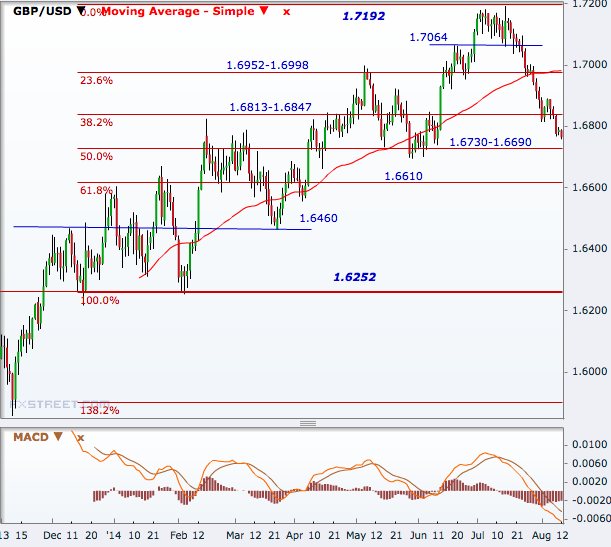Sterling Drops to New Two-Month Low Ahead of Jobs Data, Inflation Report and Q2 GDP

The British pound has fallen to a fresh two-month low against the US dollar as the market braces up for key data such as the June/July labour market numbers and the Bank of England quarterly inflation report scheduled for Wednesday.
BoE Governor Mark Carney will address the press after the inflation report, which is also going to be crucial for sterling. What follows is another important event - the second quarter GDP data, due on Friday.
The UK claimant count is forecast to have dropped by 30,000 in July compared to the 36,300 drop recorded in June. Forecasters see the ILO unemployment rate for the three months to June at 6.4%, down from 6.5% in May.
The UK economy may have grown 3.1% from a year earlier in the second quarter, unchanged from the previous quarter, according to market consensus. Analysts see the rate of sequential expansion too coming unchanged, at 0.8%.
The GBP/USD fell to 1.6770, its lowest since 11 June, and compared to the previous close of 1.6787. The sterling has weakened more than 1.96% against the dollar since July.
The pound is holding near one-month lows against the euro and the Swiss franc and a two-month low versus the yen.
Rate Hike Cues
Analysts expect the BoE inflation report to indicate when the first rate hike will be.
Though the market widely expects the first hike by February 2015, a clearer indication of the hike will drive sterling sharply higher from the low it is currently trading against the dollar.
The NIESR GDP estimate released last week showed that the think tank too expects the bank rate to move up from the record low of 0.5% in February next year.
Carney's media address that comes after a gap of several weeks is seen as an important event this week. His remarks in June and July mainly guided the sterling in the weeks that followed.
Carney's remarks of late were largely on the hawkish side, pushing the pound to new highs, before a combination of increased safe haven flows and strong US fundamentals drove the greenback broadly higher, also weakening the sterling to multi-week lows.
The GBP/USD had touched a near six-year high of 1.719 before losing ground in early July.
The recent rise in geopolitical tensions, related to Russia-Ukraine and Israel-Gaza, were the factors behind the safe haven flows to the US dollar.
Such tensions have eased a little but the markets are not yet free from the threat of them coming back anytime, and therefore, a clear dovish bias in the inflation report and/or the Carney speech can weaken the British currency to new lows.
Technical Outlook
The GBP/USD has its 2014 low at 1.6252 touched in early February and the high at 1.7192 touched in early July.
The down move since July has now distanced it almost 1.5% weaker than its 50-day moving average which stands near 1.7000 as on 12 August.
It is the steepest correction leg in the upward channel since July 2013, indicating that the upward momentum is weakening.
With the MACD below zero, the pair seems to have even more technical reasons to go further south, and in that case, the 1.6730-1.6690 region will be the first support line, that makes the 50% Fibonacci retracement of the yearly low to the yearly high.
Then comes 1.6610, near the 61.8% line, and then 1.6460, ahead of a retest of the year's low.
On the higher side, the pair will see the 1.6813-1.6847 area as the first resistance region, near the 38.2% line, and then the 23.6% retracement of 1.6952-1.6988.
Next on the topside will be 1.7064 ahead of a retest of the year's high.

© Copyright IBTimes 2024. All rights reserved.







